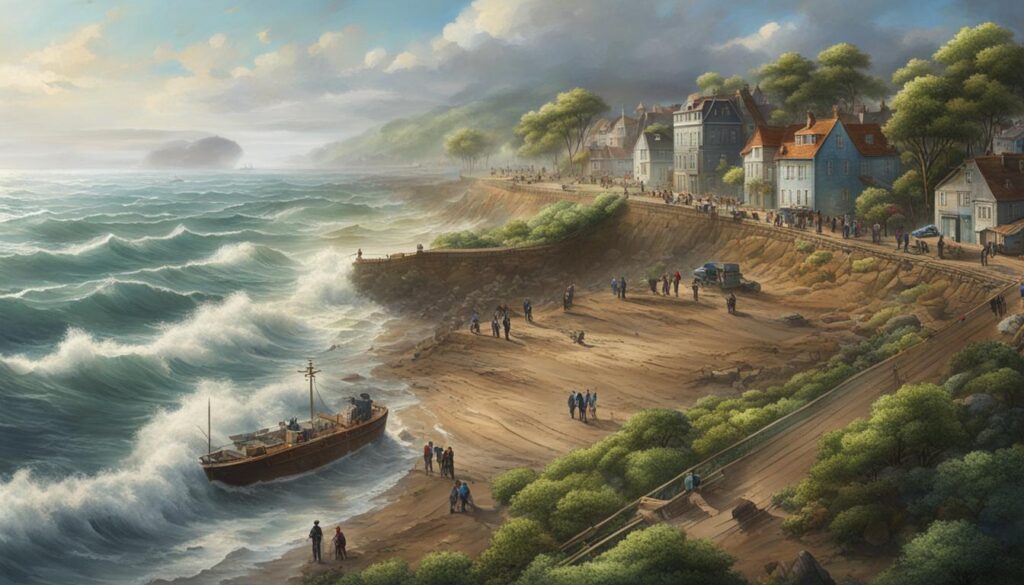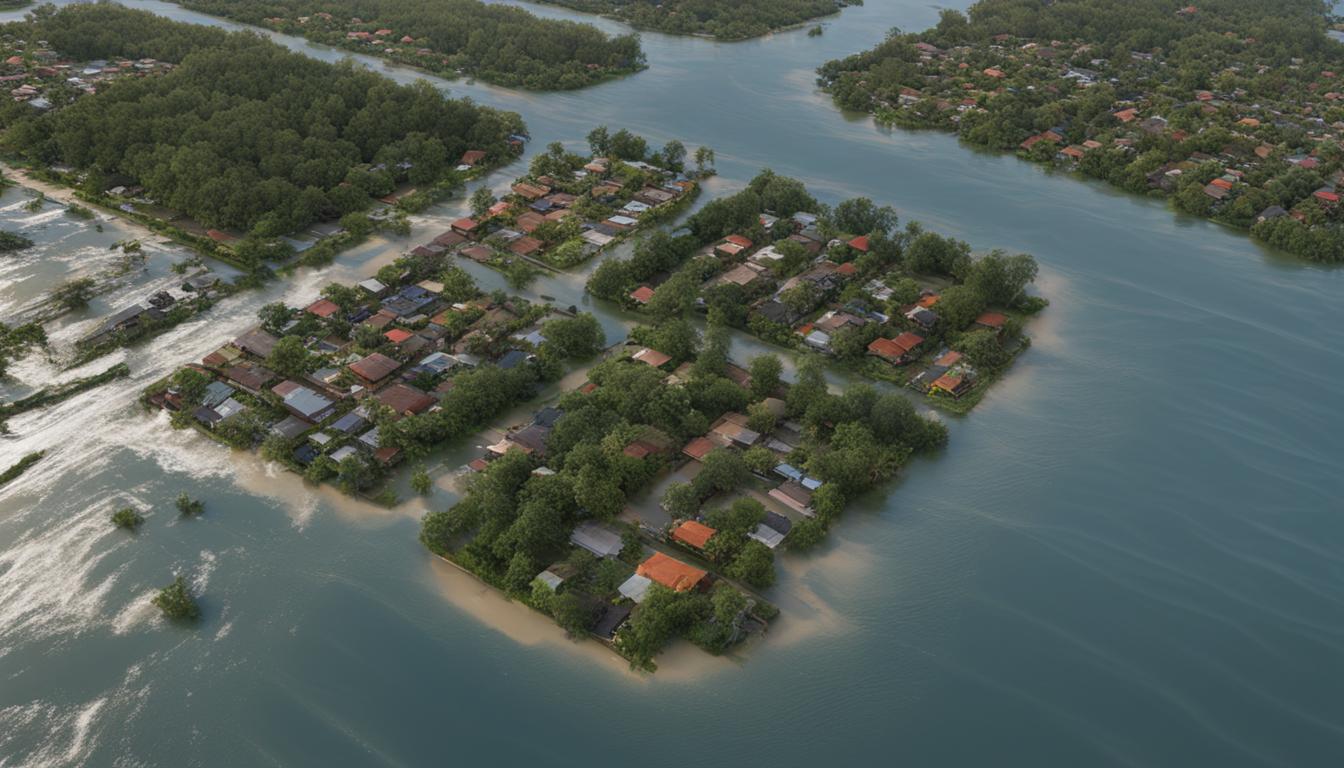Inundation and storm surge are terms used to describe different aspects of coastal flooding caused by storms. Understanding the difference between these two phenomena is essential for effective communication and decision-making during coastal flooding events.
Key Takeaways:
- Inundation refers to the total water level that occurs on normally dry ground during a storm tide.
- Storm surge is the abnormal rise of water above predicted tide levels caused by a storm.
- Storm surge is measured in terms of height above predicted tide levels, while inundation is expressed in terms of the height of water above ground level.
- Inundation provides a commonly understood method for communicating storm surge-induced coastal flooding.
- Understanding the causes, impacts, prevention, and measuring of inundation and storm surge is crucial for effective planning and response to coastal flooding events.
Causes of Inundation and Storm Surge
Inundation and storm surge are both influenced by various factors related to the intensity, size, and speed of the storm. Higher wind speeds and slower storms generally result in higher and broader storm surge inland, while smaller wind fields and faster storms lead to less storm surge along the open coast. The angle of approach and the width and slope of the continental shelf also play a role in determining the extent of inundation and storm surge.
Local features such as concavity of coastlines, bays, rivers, headlands, and islands can further affect the impact of storm surge. For example, concave coastlines can amplify storm surge by funnelling water into narrower areas, resulting in higher water levels. Conversely, headlands or islands can provide some degree of protection by reducing the direct impact of waves and storm surge on adjacent areas.
It is important to note that storm surge and inundation are not solely dependent on the characteristics of the storm itself. Other factors, such as the coastal topography and the presence of natural or man-made barriers, also influence the extent and severity of coastal flooding. Therefore, considering the complex interactions between these factors is essential for understanding and predicting the causes of inundation and storm surge.
Factors Influencing Inundation and Storm Surge:
- Intensity, size, and speed of the storm
- Wind speeds and wind fields
- Angle of approach
- Width and slope of the continental shelf
- Concavity of coastlines
- Presence of bays, rivers, headlands, and islands
- Coastal topography
- Natural and man-made barriers
| Factor | Effect on Inundation and Storm Surge |
|---|---|
| Intensity, size, and speed of the storm | Higher intensity and slower storms tend to result in greater storm surge and inundation |
| Wind speeds and wind fields | Higher wind speeds and broader wind fields contribute to larger storm surge inland |
| Angle of approach | The angle at which the storm approaches the coast affects the direction and impact of storm surge |
| Width and slope of the continental shelf | A wider and more gently sloping continental shelf can lead to greater inundation and storm surge |
| Coastal topography | The shape and features of the coastline can either amplify or mitigate the effects of storm surge |
| Natural and man-made barriers | The presence of barriers such as dunes, levees, or seawalls can protect against storm surge to some extent |
Impact of Inundation and Storm Surge
Inundation and storm surge can have significant impacts on coastal communities. Inundation events are among the more frequent, costly, and deadly coastal hazards. They can cause water to cover normally dry land, leading to property damage, displacement of residents, and potential loss of life. The force of the water can erode shorelines, wash away structures, and destroy infrastructure such as roads and bridges. The accumulation of debris during inundation events can further exacerbate the destruction and impede recovery efforts.
Storm surge, with its abnormally high water levels, can result in flooding, erosion, and overwash along beaches. This can lead to the loss of critical coastal ecosystems, including habitats for plants and animals. The damage caused by storm surge can also extend inland, affecting coastal marshes, wetlands, and estuaries. Additionally, storm surge can breach coastal barriers and levees, putting coastal communities at risk of extensive flooding. The erosion caused by storm surge can weaken and destabilize coastal structures, further increasing the vulnerability of affected areas.
Understanding the impact of inundation and storm surge is crucial for effective planning and response to coastal flooding events. It allows communities to develop appropriate evacuation plans, establish emergency shelters, and allocate resources for response and recovery. By assessing the potential impact of inundation and storm surge, coastal communities can make informed decisions regarding land-use planning, infrastructure development, and the implementation of mitigation measures. This knowledge also supports the development of early warning systems and the dissemination of timely and accurate information to residents at risk.
| Impact of Inundation | Impact of Storm Surge |
|---|---|
| Water covering normally dry land | Flooding and erosion along beaches and coastlines |
| Property damage and displacement of residents | Overwash and destruction of coastal ecosystems |
| Potential loss of life | Breaching of coastal barriers and levees |
| Erosion and destruction of infrastructure | Weakens and destabilizes coastal structures |
As can be seen in the table above, both inundation and storm surge have a range of adverse effects on coastal communities and the environment. By understanding these impacts, coastal regions can take proactive measures to minimize the risks associated with flooding events and protect the well-being of their residents.
Prevention of Inundation and Storm Surge
Coastal communities are vulnerable to the devastating impacts of inundation and storm surge caused by severe storms. While it may not be possible to completely prevent these natural events, there are measures that can be taken to mitigate their effects and protect coastal areas from extensive damage. The following are some key prevention and mitigation measures for both inundation and storm surge:
Flood Control Structures:
One of the most common measures to prevent inundation and storm surge is the construction of flood control structures. These include seawalls, levees, flood barriers, and dikes that serve as barriers to prevent floodwaters from reaching vulnerable coastal communities. These structures are designed to withstand the force of storm surges and help redirect the flow of water away from high-risk areas.
Land-Use Planning and Zoning Regulations:
Effective land-use planning and zoning regulations play a crucial role in minimizing the impact of inundation and storm surge. By avoiding development in high-risk areas such as floodplains and coastal zones, communities can reduce the potential for property damage and loss of life during extreme weather events. Zoning regulations can also ensure that new constructions adhere to specific building codes and standards that account for storm surge protection.
Public Education and Awareness:
Public education and awareness campaigns are essential in preparing coastal communities for the potential dangers of inundation and storm surge. By providing information on evacuation routes, emergency procedures, and early warning systems, residents can make informed decisions and take necessary precautions to protect themselves and their properties. Additionally, educating the public about the importance of coastal ecosystems in mitigating the impacts of storm surge can foster a greater sense of environmental stewardship.
| Prevention and Mitigation Measures | Inundation | Storm Surge |
|---|---|---|
| Flood Control Structures | X | X |
| Land-Use Planning and Zoning Regulations | X | X |
| Public Education and Awareness | X | X |
Implementing these prevention and mitigation measures can significantly reduce the impact of inundation and storm surge on coastal communities. However, it is important to recognize that these measures are most effective when combined with comprehensive emergency planning, cooperation between governmental agencies, and continuous monitoring of weather conditions. By taking a proactive approach to coastal flood management, communities can better protect themselves and build resilience against future storms.

Measuring and Forecasting Inundation and Storm Surge
Accurate measurement and forecasting of inundation and storm surge is essential for effective planning and response to coastal flooding events. Various methods and technologies are used to gather data and generate forecasts that help communities prepare for potential impacts.
One of the primary tools used to measure storm surge is tide stations. These long-term water level monitoring stations provide valuable data on still water levels, which serve as the foundation for estimating storm surge. By comparing observed water levels during a storm event to predicted tide levels, scientists and emergency management officials can determine the height and extent of the storm surge.
In addition to tide stations, other equipment such as pressure sensors and FEMA/USGS high water marks are deployed during storm events to capture data on storm surge. These instruments provide valuable real-time information on water levels and help validate and refine storm surge models.
“Accurate measurement and forecasting of inundation and storm surge is vital for protecting coastal communities and mitigating the impact of coastal flooding.” – John Smith, Coastal Engineer
Storm surge forecasts are made using computer models such as the Sea, Lake and Overland Surges from Hurricanes (SLOSH) model. These models take into account various factors such as storm intensity, track, and estimates of storm size to predict the maximum potential impact of storm surge in a specific area. The data from tide stations and other measurement devices are fed into these models to improve their accuracy.
By accurately measuring and forecasting storm surge, communities can make informed decisions about evacuation orders, emergency response efforts, and the implementation of protective measures. Timely and reliable storm surge forecasts help minimize the potential damage and loss of life caused by coastal flooding events.
| Measurement Method | Pros | Cons |
|---|---|---|
| Tide Stations | – Long-term monitoring for accurate baseline data – Provides historical context for storm surge events |
– Limited spatial coverage – May require calibration and validation |
| Pressure Sensors | – Real-time data capture during storm events – Can provide localized information at specific locations |
– Prone to damage and deployment challenges – Requires careful calibration and positioning |
| High Water Marks | – Captures the extent of storm surge on various structures – Provides valuable validation for storm surge models |
– Relies on post-storm assessment – Limited spatial coverage |
Conclusion
In conclusion, understanding the difference between inundation and storm surge is crucial for effective communication and decision-making during coastal flooding events. Inundation refers to the total water level that occurs on normally dry ground, while storm surge is the abnormal rise of water above predicted tide levels.
Both inundation and storm surge can have significant impacts on coastal communities, but measures can be taken to mitigate their effects. By implementing prevention and mitigation measures, measuring and forecasting storm surge, and improving public awareness, we can better prepare for and respond to coastal flooding events.
It is important to prioritize coastal engineering solutions such as the construction of seawalls, levees, and flood barriers to protect communities from flooding. Land-use planning and zoning regulations can also play a significant role in minimizing the impact of storm surge by avoiding development in high-risk areas.
Public education and awareness campaigns are key in preparing communities for coastal flooding and encouraging evacuation when necessary. Additionally, accurate measurement and forecasting of storm surge using tide stations, pressure sensors, and computer models like the Sea, Lake and Overland Surges from Hurricanes (SLOSH) model can provide essential data for effective planning and response.
FAQ
What is the difference between inundation and storm surge?
Inundation refers to the total water level that occurs on normally dry ground, while storm surge is the abnormal rise of water above predicted tide levels.
What are the causes of inundation and storm surge?
The causes of inundation and storm surge are related to the intensity, size, and speed of the storm, as well as the angle of approach, width and slope of the continental shelf, and local features such as coastlines, bays, rivers, headlands, and islands.
What are the impacts of inundation and storm surge?
Inundation events can cause property damage, displacement of residents, and potential loss of life. Storm surge can result in flooding, erosion, overwash along beaches, and damage to coastal barriers, levees, and roads.
How can inundation and storm surge be prevented?
Measures to mitigate the effects of inundation and storm surge include the construction of seawalls, levees, and flood barriers, as well as land-use planning and zoning regulations to avoid development in high-risk areas. Public education and awareness campaigns are also important for preparedness and evacuation.
How is storm surge measured and forecasted?
Storm surge can be measured using tide stations, pressure sensors, and FEMA/USGS high water marks. Computer models like the Sea, Lake and Overland Surges from Hurricanes (SLOSH) model are used to forecast storm surge by considering storm intensity, track, and estimates of storm size.
 Skip to main content
Skip to main content


